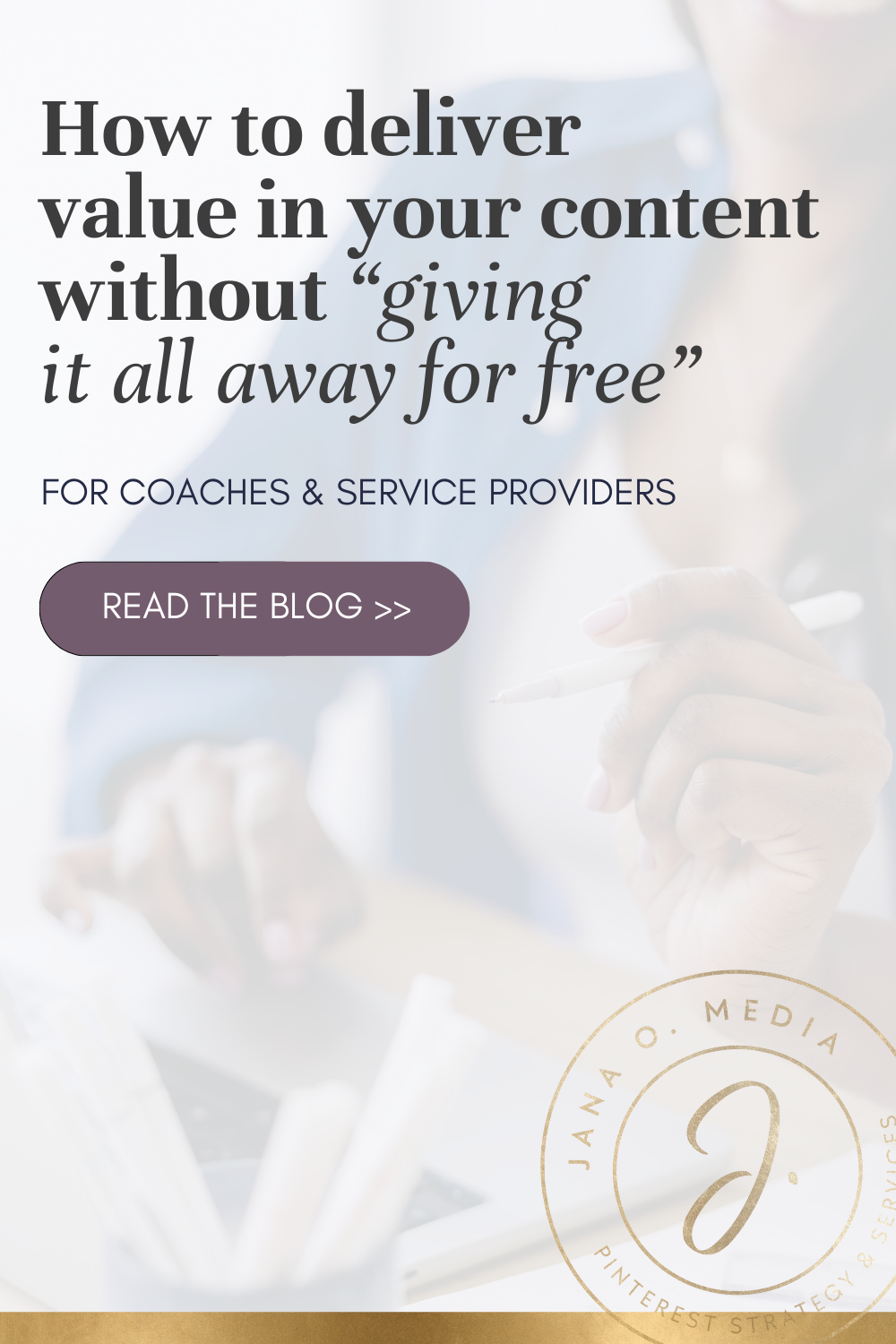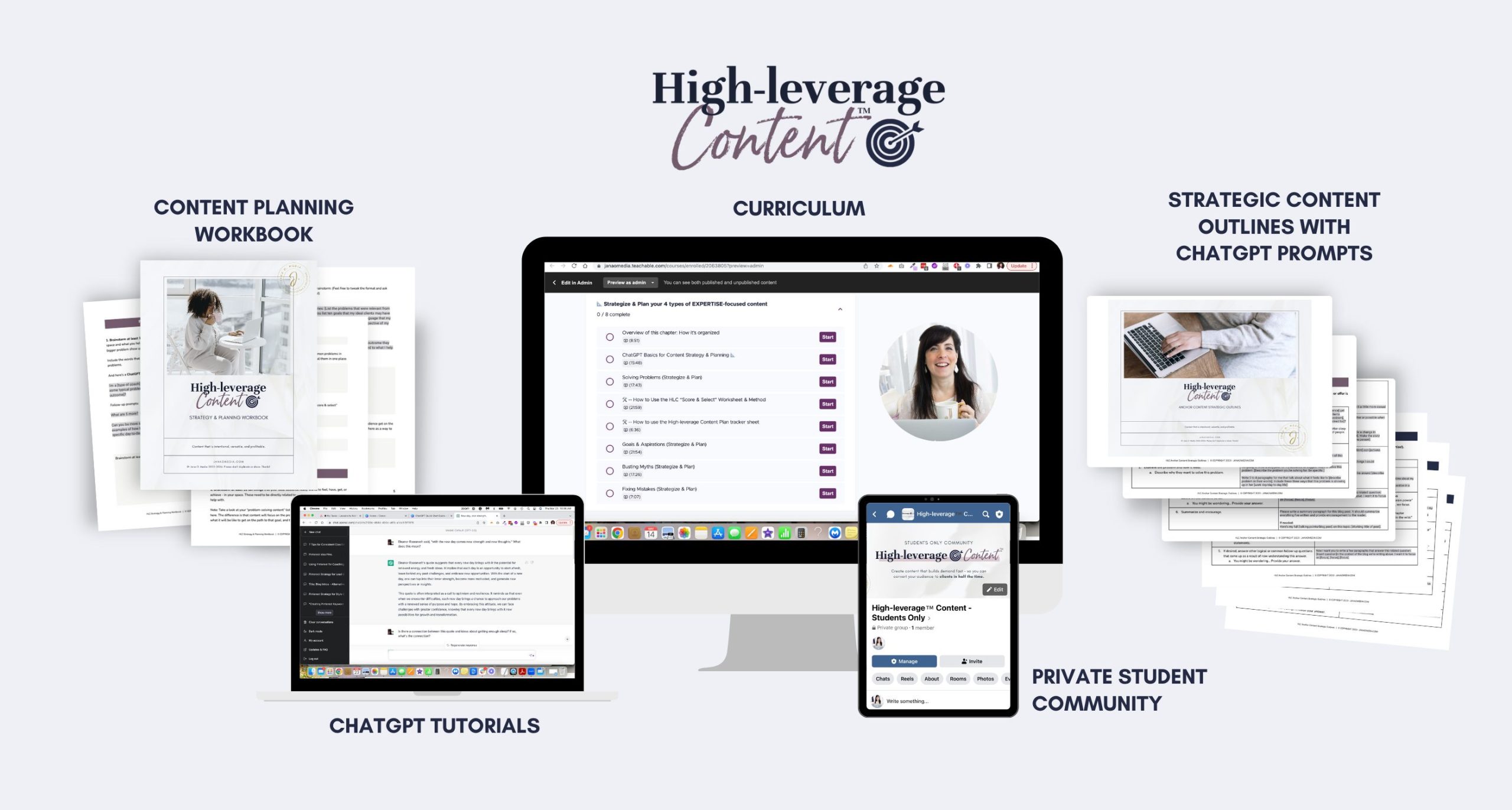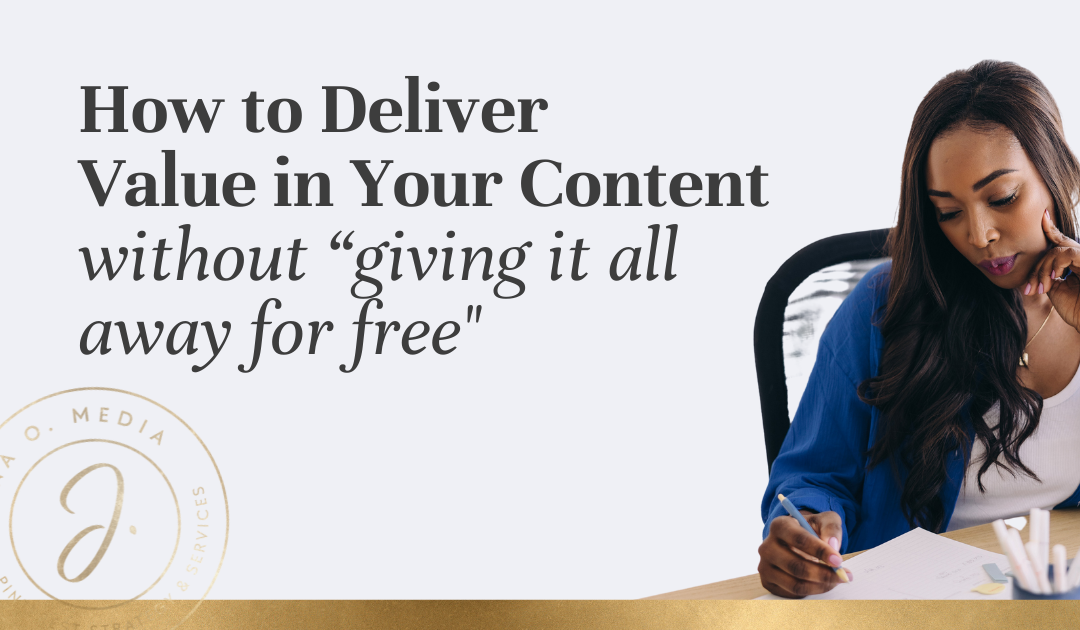As a wellness or self-improvement coach, you know the importance of sharing valuable marketing content to connect with your audience, establish your expertise, and get clients.
But there’s this nagging concern in the back of your mind, almost every time you write content…
“Am I giving too much away for free?” 😬
Will people be willing to pay to work with you, if they can learn from you for free in your content?
I know you wonder this sometimes — and it’s really slowing you down.
Maybe you’ve found yourself spending hours crafting detailed posts, only to worry afterward that you’ve shared too much?
Or you’ve hesitated to publish certain topics that your audience would *love* to learn from you, fearing they reveal too much of your coaching secrets?
Or worse, you might feel paralyzed, unsure what to write about that isn’t “too much,” leading to inconsistent posting and feeling invisible. 😣
(And… All of this is just exacerbated by the fact that there’s conflicting advice out there… Some gurus say, “Just give it all away for free!” … While others talk about the need to “gate content” if you want to earn a living in this space.)
Okay, so…
What’s the solution?
In this blog post, I’m going to share my philosophy about this. (Spoiler: You might be surprised by my thoughts… I actually fall more into the “hold some of your best stuff back” camp!)
And I’m going to touch on 4 specific strategies for striking the right balance in your marketing content…
So you can write content that your audience wants to read and will just *eat right up* — without giving away all your best stuff for free!
Here’s what I’m covering… (You can click on any link to jump to that section.)
And then…
- Strategy 1: Give valuable perception-shifts, instead of always giving all how-to’s.
- Strategy 2: Zoom in and cover a small part of the problem, thoroughly.
- Strategy 3: Offer 3 strategies and make something in your offer one or two of them.
- Strategy 4: Cover the “what” but not the “how.” (<< I’ve got a caveat ⚠️ about this one!)
Let’s start with a quick preface, because I KNOW you might be thinking…
Wait, is it even possible to “give too much away for free?”
As mentioned above, I have a slightly controversial take on this topic:
I believe that, if you’re not careful, you can give away too much for free, and thereby overwhelm your audience and even cannibalize your paid offers.
I know the party line in the online space is “No, you can’t be too generous. Give it all away for free to build trust, attract followers, and establish yourself as an authority.
And I do believe that this very abundant way of thinking has some merit. (I love me some abundance mindset 💪🏼… and I DO want you to have it, too!)
But I also think that when people give this advice, they are sort of sweeping the real issues (and your legit concerns) under the rug… 🤷🏻♀️I said what I said…
Because here’s the catch with just giving it all away in your free content:
While generosity is good, there’s a fine line between that and offering so much value that you firehose your audience with information.
And frankly, it can leave people with the impression (conscious or un) that they don’t need your services (because after all, they are still working through your copious amounts of free content).
So, bottom line…
You need to be strategic with your generosity, ensuring that your free content serves as a teaser, not a substitute for what you offer. 🎯
This isn’t about holding back to manipulate your audience; it’s about recognizing the nuances of effective content marketing, where the goal is to inspire and inform while walking your audience down a customer journey path that leads to your paid offers.
The truth is that this issue is very nuanced… And some of those nuances are different, depending on your what type of offers you sell (coaching vs. courses, for example), how large your audience is, and other factors.
So… I encourage you to hold space for both abundance and discernment…
✔️ Yes, have an abundance mindset. Know that, even when you share a lot of your best ideas, your clients will still want to hire you for personalized support, accountability, space-holding, getting stuff done…. (especially if you’re a coach or provide 1:1 services of any type).
✔️ And yes, ALSO, familiarize yourself with the strategies I’m outlining below. Lean on them when you want to give lots of satisfying value to your audience, without under-cutting your paid offers.
Making space for both of these truths will allow you to build trust and authority *while also* guiding your audience through a journey that naturally leads to your premium services.
Okay… {**Steps off soapbox.}
Now let’s get into the nitty-gritties… I’m about to show you how you can find this important balance in your marketing content.
Here are 4 strategies for delivering satisfying value in your content without “giving it all away for free…”
1. Choose topics that shift beliefs or perceptions, instead of always giving all how-to’s.
HOW IT WORKS:
Tips, tricks, and how-to’s are NOT the only way to provide value!
With this technique, you focus some of your content (at least half) on calling out your audience’s underlying beliefs and perspectives that are slowing them down… or not serving them…
And you provide value by helping them see something differently, rather than providing more tips, tricks, or how-to’s.
Changing beliefs is a powerful way to engage your audience on a deeper level. It helps your audience see the value of your specific approach and positions you as a thought leader.
It prompts them to consider new perspectives and creates a desire to learn more from you. It capitalizes on the fact that most people don’t need more information — but rather they need help with understanding it better, and with facilitating change.
Using this technique, you don’t need to reveal your entire methodology, which could easily lead your audience to think, “Oh, that’s super-smart. Now I can easily try that on my own.”
When done well, this all leads to better conversions.
WHEN TO USE IT :
Use this in the Content Planning phase — when you are choosing topics for your content that will convert.
Note: Inside my signature program, High-leverage Content, I teach my (now-famous!) ‘9-in-2 Content Pillars’ framework. It’s based on the 9 types of content that your audience needs from you, to feel ready to buy.
Three of the nine pillars represent different approaches to content that shifts beliefs and perspectives. I provide strategic content outlines for each pillar, so you can easily craft these especially-high-converting posts. You can click here to learn more about High-leverage Content.
Okay, let’s look at the next strategy…
2. Zoom in on a very small (but important) part / aspect of the big problem or goal, and cover it thoroughly.
HOW IT WORKS:
Instead of tackling an entire issue, you’ll focus on a smaller, manageable part of the larger problem or desire your audience has.
By thoroughly covering and solving a specific aspect of a problem, you demonstrate expertise and offer immediate value.
This piques your audience’s interest and establishes trust, making them more likely to seek out your services for comprehensive solutions…
And it’s actually a lot easier to be highly-relevant and specific, when you zoom in on a small, real, everyday problem (as opposed to being very “high-level” which often makes your content get overlooked, because it can feel generic.)
WHEN TO USE IT :
This one will also be part of your Content Planning phase — when you are choosing topics for your content that will convert.

(Pssssst…. 📌 Pin this for reference to your “Coaching Marketing Ideas” board.)
3. Offer three strategies and make something in your offer one or two of them. (The Content-to- Client Bridge)
This is my favorite of the three methods, and you’ll notice I use it a lot, in my own blog posts. I call this “The Content-to-Client Bridge.”
HOW IT WORKS:
In this technique, you present three* practical strategies that your audience can implement. All three roll up to the topic of your post.
You freely share plenty of juicy details 1 or 2 strategies (yes, they can be how-to’s or tips!).
The third strategy (or the second and third) is something that you do inside your paid offer. For these, you describe them at a high level, focusing on the benefits and outcomes (not the how-to’s).
(*Note: You could include a total of 4 or 5 strategies, but three is plenty, so make it easy on yourself, unless you’re dying to include more than three!)
By using this “Content-to-Client Bridge” approach, you can deliver actionable details to your audience while also showing the value of your paid services for more specialized or comprehensive support. You’re maintaining the integrity of your free content while *also* positioning your paid offerings as essential for achieving optimal results… It’s a WIN-WIN!
WHEN TO USE IT :
Use this technique in the Content Outlining Phase.
(Outlining is Step 1 of my 4-Step “Light & Logical” Writing Process, inside High-leverage Content.) While you’re determining what you will cover, you’ll identify the strategies you want to share based on the above.
Okay last technique to mention…
4. Cover the “what” but not the “how.”
This strategy might sound familiar, as it’s often recommended in content marketing.
And, ⚠️⚠️CAVEAT: It’s not my favorite strategy. (I’ll explain below.) But I think it merits a mention here, so let’s discuss it…
HOW IT WORKS:
The idea is simple: focus on explaining what needs to be done to solve a problem or achieve a goal, without delving into the specifics of how to do it.
By doing so, you provide valuable insights that highlight your expertise, while reserving the detailed execution and/or personalized advice for your paid offerings.
Basically, you’re outlining the key elements or steps involved, but intentionally leaving out the detailed instructions. The “what” provides your audience with a clear understanding of the concepts and why they are important, while the “how” is reserved for those who invest in your services or products.
WHEN TO USE IT :
When you use this technique, use it in the Content Drafting and Fleshing Out Phases. (These are Steps 3 and 4 of my 4-Step “Light & Logical” Writing Process, inside High-leverage Content.) While you’re writing, you’ll detail the “what” but stop short of the “how” part.
CAUTION: ⚠️⚠️
While this is a popular and often-prescribed strategy, I think it needs to be used selectively.
It’s cool to use this in *some* of your long-form content, but I want you to mix it in with the other three strategies I showed you above…
Because if you relying solely on this “what not how” method, you run the risk of having a bunch of flimsy-feeling posts that really only scratches the surface of topics. They could potentially leaving your audience feeling unfulfilled and questioning your depth of knowledge.
So you can use this, but be sure to only use it sometimes, k?
Are you feeling more equipped to deliver valuable, in-depth content without giving away all your expertise for free?
I hope this article has helped clarify that balance!
It’s so important these days to provide high-quality content to your audience (so you can build trust and demand) — while still maintaining a boundary between what’s free from you, and what’s not.
I designed High-leverage Content (my system and course) to give you everything you need to do this with grace and ease! 🎯
You’ll be able to master the value-boundaries balance, inside High-leverage Content.
Inside HLC, you’ll create a library of long-form content that converts your audience to clients quickly, helping you grow a roster of clients that makes you proud!
The techniques we’ve discussed above can be applied in the different stages I teach you inside — from topic selection to outlining, drafting, and fleshing-out your pieces.
When you enroll, you’ll learn how to choose high-converting content topics, using my ‘9-in-2 Content Pillars.’
These are the 9 types of content your audience needs, to be ready to buy. And they also ensure that you strike juuuuuuust the right balance between actionable how-to’s, belief- and perspective-shifting content, and conversion-focused content.
(I teach the 9-in-2 Content Pillars in the first 1 hours inside the curriculum, so you can start using them immediately to get more conversions, faster, with your marketing!)
You’ll also get my 9 ‘HLC Strategic Content Outlines.’
These show you, line-by-line, paragraph-by-paragraph, how to structure blog posts (or talking points or scripts for podcast or Youtube episodes). Using these outlines as a guide when you write makes producing content go SO MUCH faster… But also, more importantly, they ensure that you won’t miss key elements that make your content convert.
💪🏼💪🏼💪🏼
If you’ve struggled in the past with the feeling like you’re “giving it all away for free” in your content, in order to effectively attract people to your paid services… High-leverage Content is just what you need.
You will learn *exactly* how to make the necessary shifts — and go from a bunch of “dead-end” how-to’s that don’t convert… to more strategic thought leadership content that gets clients excited to work with you. 😎
Join us inside!



